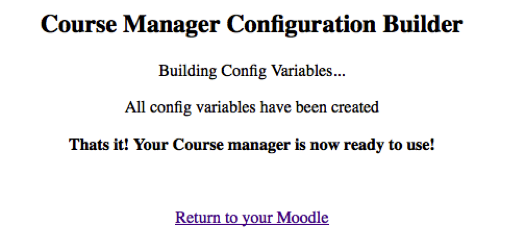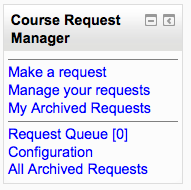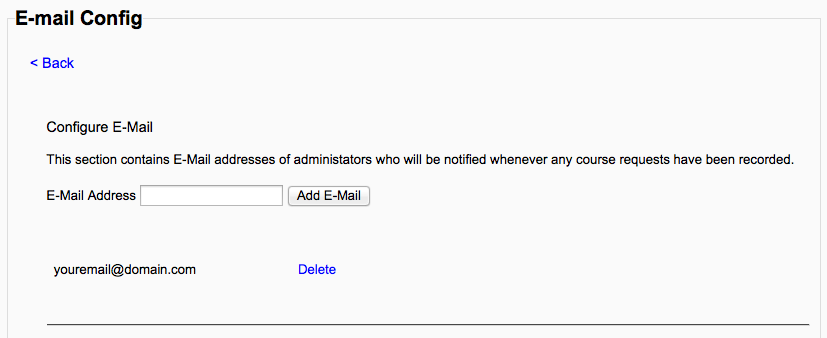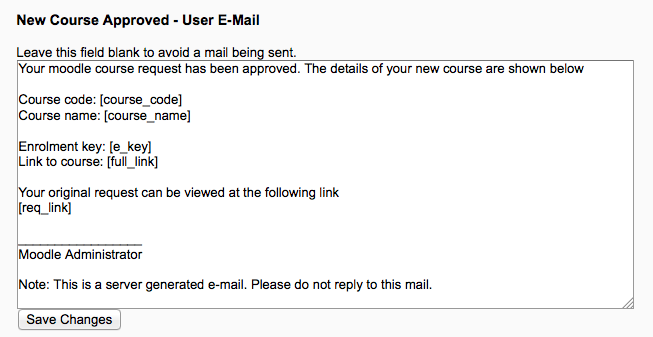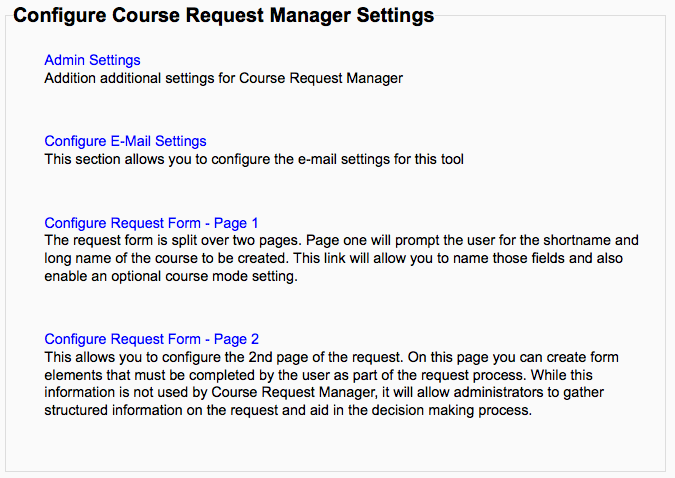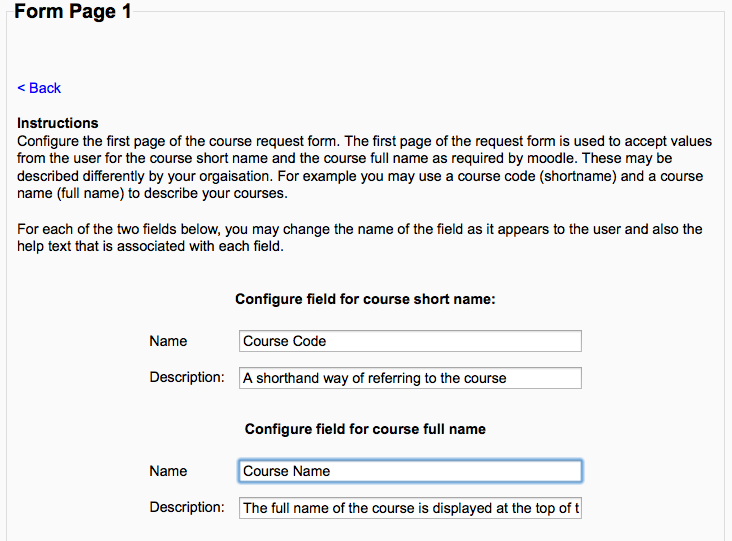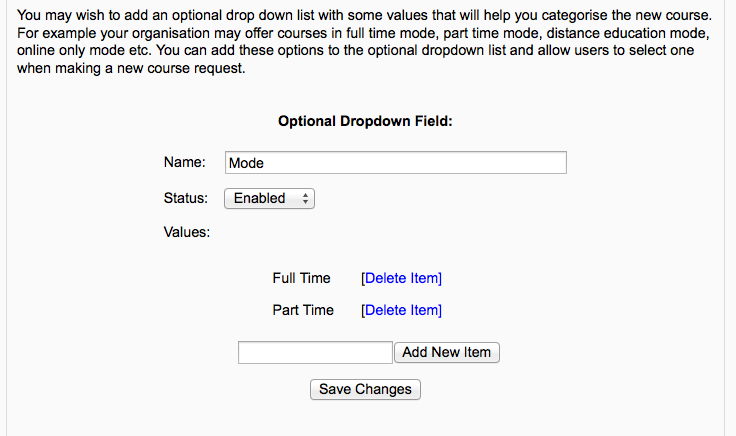blocks/cmanager/: Difference between revisions
No edit summary |
No edit summary |
||
| Line 164: | Line 164: | ||
Now that you have configured the email and naming conventions, it is time to configure the request form for your users. Back on the main config page, select the Configure Request Form - Page 1 link. | Now that you have configured the email and naming conventions, it is time to configure the request form for your users. Back on the main config page, select the Configure Request Form - Page 1 link. | ||
[[File:cmanager7.png]] | |||
The course request form is actually broken into two pages. The first page of the request form is used to accept values from the user for the course short name and the course full name as required by moodle. These may be described differently by your orgaisation. For example you may use a course code (shortname) and a course name (full name) to describe your courses. For each of the two fields below, you may change the name of the field as it appears to the user and also the help text that is associated with each field. | |||
[[File:cmanager8.png]] | |||
The second part of this form allows you to add an optional ‘mode’ dropdown to the course request. In many educational institutions, the same course or module may be delivered in different modes (part-time, full-time, online etc). By default this option is disabled (hidden from form) but it may be enabled. You may rename the mode field name which will be displayed to the user and also add/delete modes. | |||
[[File:cmanager9.png]] | |||
Scroll down and click on the save changed button to apply any changes. | |||
== Configure Request Form - Page 2== | |||
The second page of the request form is where you can configure the additional fields that will allow users to enter/select the required data which is used to help you make a decision when handling a course request. | |||
'''Setting the current active form''' | |||
The current active form needs to be set. By default the current active form is the Default form. The Default form is a single text area which prompts the user for more information. This form may be used but it is suggested that you add a new form and configure its form elements. | |||
[[File:File:cmanager10.png]] | |||
8.2. Manage Forms | |||
Here you can add, delete and preview new forms. | |||
To delete a form simply click on the delete icon. | |||
To preview a form, simply click on the preview icon. | |||
To edit a form, simply click on its name. | |||
To create a new form, simply enter the form name and click on the ‘Create a new form’ button. | |||
[[File:cmanager11.png]] | |||
In the example below, I have added a new form called ‘test’. To begin editing the form, click on the form name (link) | |||
[[File:cmanager12.png]] | |||
Revision as of 15:55, 25 July 2012
Course Request Manager for Moodle 2
Introduction
This guide is aimed at a Moodle administrator who would like to start using the Course Request Manager(CRM) block for Moodle to help improve their user course request process.
System Requirements
The Course Request manager block requires Moodle 2.3 and above. A Moodle 1.9 version (unsupported) can also be downloaded from github. GITHUB
Installation of Course Request Manager
The Course Request Manager block is added like other blocks (How to install a block).
Once the Course Request Manager block is installed, it is recommended that you add the block to the front page.
Once added, the block will run a short configuration script that will initialise course request manager for your moodle installation.
Accessing configuration settings
It is recommended that administrators configure the course request manager before first use.
Once the block has been added to the frontpage, you should see the new course request manager block as shown below
Click on the Configuration link to begin configuring the request manager.
You will be presented with three options
- Configure Course Request Manager Settings Course Request Manager settings allows you to set administrator emails for communication, set default emails, set course naming conventions and default course settings such as start date and enrolment key policy.
- Configure Request Form - Page 1 The request form is split over two pages. Page one will prompt the user for the shortname and long name of the course to be created. This link will allow you to name those fields and also enabe an optional course mode setting.
- Configure Request Form - Page 2 This allows you to configure the 2nd page of the request. On this page you can create form elements that must be completed by the user as part of the request process. While this information is not used by Course Request Manager, it will allow administrators to gather structured information on the request and aid in the decision making process.
We will look at each of these in turn. Lets start by looking at the Configure Course Request Manager Settings option.
Configure Course Request Manager Settings – Configuring Email Settings
The Configure Course Request Manager screen allows the administrator to configure communication emails as well as some of the course naming conventions etc.
The first recommended step involves adding at least one email address of an administrator who will handle course requests. The system has been set up with a dummy email address (youremail@domain.com), which should be deleted. To enter a new email, simply enter the email address and click on the ‘Add E-Mail’ button.
In this section you can also configure the default emails that are sent at the various stages of a course request. There are 11 possible emails that may be sent by the request manager.
New Course Approved User E-Mail
This email is sent to the user when a course request has been approved by the administrator.
New Course Approved - Admin E-Mail A copy of the above email sent to the listed admin emails.
Request New Course - User E-Mail This email is sent to the user as confirmation that a course request has been logged with the system.
Request New Course - Admin E-Mail A copy of the above email sent to the listed admin emails.
Comment Notification E-Mail - User E-Mail An email is sent to the requestor when a comment is added to a course request.
Comment Notification E-Mail - Admin E-Mail An email is sent to the listed administrators when a comment is added to a course request.
Request Denied E-Mail - User E-Mail This email is sent to the requestor when a course request is denied.
Request Denied E-Mail - Admin E-Mail This email is sent to the listed administrators when a course request is denied.
Handover Request - Current Owner E-Mail If a user puts in a course request for a course that already exists on the moodle server, then a course handover process may commence. In this case, an email is sent to the current listed owner(s) of the module requesting that control or access is granted to the requestor (this may be denied).
Handover Request - User E-Mail A copy of the above email which is sent to the requestor.
Handover Request - Admin E-Mail A copy of the above email which is sent to the listed administrators.
Each of the emails has already been initialised with default text. To change an email, simply update the contents in the relevant text area and click on the associated save changes button. (shown below)
In the above image, you can see that the text also contains a number of ‘tags’ that can be inserted into the mail. These can include
Course code: [course_code] Course name: [course_name] Enrolment key: [e_key] Full URL to new course: [full_link] Full Course Request Manager request summary link: [req_link]
When a tag is included, the relevant information will be included in the sent email.
IMPORTANT: To disable an email, simply delete the contents of the text area for that email (including any spaces etc) and click on Save.
Configure Course Request Manager Settings – Configuring Other Settings
Clicking on the ‘Other Settings’ tab will show the following page
On this page, administrators may change several options which are explained below
Course Naming Convention This option allows you to set a naming convention to courses when they are created as a result of an approved request. By default the course naming convention is full name only. Other options include - Short name – Full name - Full Name (Short Name)
Short Name Format The short name format may be altered to include a course mode. The course mode is an optional setting which will be discussed later in the document.
This is useful where two version of the same course may exist on moodle that are delivered in different modes (part time vs full time). The Short Name format may be altered to include this. Enrolment Key By default the enrolment key is automatically generated when the course is created. The CRM block will generate a random 4 number code which will be sent to the user (assuming email is enabled). If you would like to allow users to specify their own enrolment keys during a request, please change the setting to ‘Prompt user for key’
Communications Email Address Simply enter an email address here which will appear as the sender email address in all communication mails sent from the block. A noreply type mail is recommended e.g noreply@mymoodleserver.domain
Start Date Here you can set the default start date for newly created courses. This may be useful when newly created courses should have a common start date (e.g. the start date for an academic term)
Configure Request Form - Page 1
Now that you have configured the email and naming conventions, it is time to configure the request form for your users. Back on the main config page, select the Configure Request Form - Page 1 link.
The course request form is actually broken into two pages. The first page of the request form is used to accept values from the user for the course short name and the course full name as required by moodle. These may be described differently by your orgaisation. For example you may use a course code (shortname) and a course name (full name) to describe your courses. For each of the two fields below, you may change the name of the field as it appears to the user and also the help text that is associated with each field.
The second part of this form allows you to add an optional ‘mode’ dropdown to the course request. In many educational institutions, the same course or module may be delivered in different modes (part-time, full-time, online etc). By default this option is disabled (hidden from form) but it may be enabled. You may rename the mode field name which will be displayed to the user and also add/delete modes.
Scroll down and click on the save changed button to apply any changes.
Configure Request Form - Page 2
The second page of the request form is where you can configure the additional fields that will allow users to enter/select the required data which is used to help you make a decision when handling a course request.
Setting the current active form
The current active form needs to be set. By default the current active form is the Default form. The Default form is a single text area which prompts the user for more information. This form may be used but it is suggested that you add a new form and configure its form elements.
8.2. Manage Forms
Here you can add, delete and preview new forms.
To delete a form simply click on the delete icon. To preview a form, simply click on the preview icon. To edit a form, simply click on its name.
To create a new form, simply enter the form name and click on the ‘Create a new form’ button.
In the example below, I have added a new form called ‘test’. To begin editing the form, click on the form name (link)

